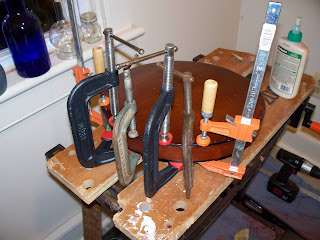This adventure started about a month or so ago. During a dinner conversation, my parent-in-laws mentioned how they wanted new coffee mugs from "a local artist." Of course my immediate reaction is "I bet I can make that." Some time passed and my wife(Oz) brings home a potters wheel and we get to work. Let me mention I have never worked clay on a wheel and the last time I even touched clay must have been 10 years ago at this point.
On the first day of attempts, I mangled some lumps of clay and tried to figure out centering. Nothing of mine survived the first day. Oz came away with a small bowl.

On the first day of attempts, I mangled some lumps of clay and tried to figure out centering. Nothing of mine survived the first day. Oz came away with a small bowl.

On the second and third day of pot throwing we were both much more successful!
We put handles on our mugs(called "pulling a handle") and then let all the clay dry for a few days. Once nearly all of the moisture has left the clay, it's ready to be fired in the kiln! After it comes out it becomes bisqueware.
The next step in the process is glazing. We took the simple route and just dipped the mugs and bowls into vats of glaze.
The next step is to put the glazed pottery back into the kiln to be fired again. One peculiar aspect of the glazes we were using is the appearance before and after firing. Take a look at all the before and after shots!
Oz's mugs and bowls:
I'm so glad everything survived two firings but turns out we made a lot of these too small. Unless you happen to prefer coffee and tea in amounts less than 8 oz. in which case you'd be set. Sadly using the wheel is a terrible mess and we'll have to wait til the spring to do more outside. For a first attempt I'm very pleased.
(I know I've forgotten to put up finished pictures of my violin but I'll put them up shortly and hopefully a video to go with it. It works but it's so very heavy!)
(I know I've forgotten to put up finished pictures of my violin but I'll put them up shortly and hopefully a video to go with it. It works but it's so very heavy!)




















































